1994 PONTIAC BONNEVILLE brake
[x] Cancel search: brakePage 151 of 290

Your Driving and the Road
I
Driving in the Rain
(CONX)
Driving too fast through large water
puddles or even going through some car
washes can cause problems, too. The
water may affect your brakes.
Try to
avoid puddles. But
if you can’t, try to
slow down before you hit them.
Hydroplaning
Hydroplaning is dangerous. So much
water can build up under your tires that
they can actually ride on the water. This
can happen
if the road is wet enough and
you’re going fast enough. When your
vehicle is hydroplaning, it has little or no
contact with the road.
Hydroplaning doesn’t happen often.
But it
can if your tires haven’t much tread or if
the pressure in one or more is low.
It can
happen if a lot of water is standing on the
road. If you can see reflections from trees,
telephone poles, or other vehicles, and *aindrops “dimple” the water’s surface,
;here
could be hydroplaning.
Hydroplaning usually happens at higher
;peeds. There just isn’t a hard and fast
ule about hydroplaning. The best advice
is to slow down when it is raining.
Some Other Rainy
Weather Tips
Turn on your low-beam headlights --
not just your parking lights -- to help
make you more visible to others.
Besides slowing down, allow some
extra following distance. And be
especially careful
when you pass
another vehicle. Allow yourself more
clear room ahead, and be prepared to
have your view restricted by road
spray.
Have good tires with proper tread
depth. (See “Tires” in the Index.)
. . 150
ProCarManuals.com
Page 157 of 290

Your Driving and the Road
Driving on Snow or Ice
(CONT.)
What’s the worst time for this? “Wet ice.”
Very cold snow or
ice can be slick and
hard to drive
on. But wet ice can be even
more trouble because it may offer the
least traction of all.
You can get “wet ice”
when it’s about freezing
(32°F; OOC) and
freezing rain begins to fall. Try to avoid
driving
on wet ice until salt and sand
crews can get there.
Whatever the condition
-- smooth ice,
packed, blowing or loose snow
-- drive
with caution.
If
you have traction control, keep the
system on. It will improve your ability to
accelerate when driving
on a slippery
road. Even though your vehicle has a
traction control system,
you’ll want to
slow down and adjust your driving
to the
road conditions. See “Traction Control
System”
in the Index.
If
you don’t have the traction control
system, accelerate gently. Try not to break
the fragile traction. If
you accelerate too
fast, the drive wheels will spin and polish
the surface under the tires even more. Your
anti-lock brakes improve
your
ability to make a hard stop on a slippery
road. Even though
you have the anti-lock
braking system, you’ll want
to begin
stopping sooner than you would
on dry
pavement. See “Anti-lock”
in the Index.
0 Allow greater following distance on
any slippery road.
Watch for slippery spots. The road
might be fine until
you hit a spot that’s
covered with ice. On an otherwise
clear road, ice patches may appear in
shaded areas where the
sun can’t
reach: around clumps of trees, behind
buildings, or under bridges.
Sometimes the surface of a curve or
an overpass may remain icy when the
surrounding roads are clear. If you see
a patch of ice ahead of you, brake
before
you are on it. Try not to brake
while you’re actually on the ice, and
avoid sudden steering maneuvers.
If You’re Caught in a
Blizzard
If you are stopped by heavy snow, you
could be
in a serious situation. You should
probably stay with your vehicle unless
you know for sure that you are near help and you can hike through the snow. Here
are some things to do to summon help and
keep yourself and your passengers safe:
0
0
Turn on your hazard flashers.
Tie a red cloth to your vehicle to alert
police that you’ve been stopped by the
snow.
... 156
ProCarManuals.com
Page 162 of 290
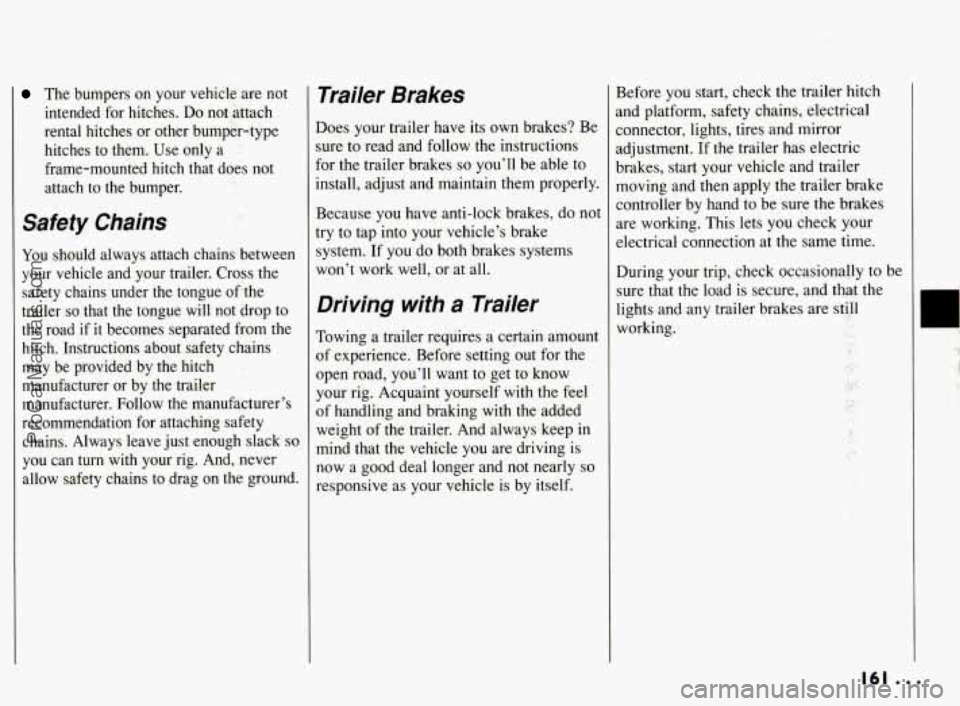
The bumpers on yaur vehicfe are not
intended for hitches.
Do not attach
rental hitches or other bumper-type
hitches to them. Use
only a
frame-mounted hitch that does not
attach to the bumper.
Safety Chains
You should always attach chains- between
your vehicle and your trailer. Cross the
safety chains under the tongue of.the
trailer
so that the tongue will not drop to
the road
if it becomes separated from the
hitch. Instructions about safety chains
may be provided by the hitch
manufacturer or by the trailer
manufacturer. Follow the manufacturer’s
recommendation for attaching safety
chains. Always leave just enough slack
so
you can turn with your rig. And, never
allow safety chains to drag
on the ground.
Trailer Brakes
Does your trailer have its own brakes? Be
sure to read and follow the instructions
for the trailer brakes
so you’ll be able to
install, adjust and maintain them properly.
Because you have anti-lock brakes, do not
try to tap into your vehicle’s brake
system. If you do both brakes systems
won’t work well, or at all.
Driving with a Trailer
Towing a trailer requires a certain amount
of experience. Before setting out for the
open road, you’ll want to get to know
your rig. Acquaint yourself with the feel
of handling and braking with the added
weight of the trailer. And always keep in
mind that the vehicle
you are driving is
now a good deal longer and not nearly
so
responsive as your vehicle is by itself. Before you
start, check the trailer hitch
and platform, safety chains, electrical
Eonnector, lights, tires and mirror
adjustment.
If the trailer has electric
brakes, start your vehicle and trailer
moving and then apply ‘the trailer brake
controller by hand to be sure the brakes
are working. This lets you check your
electrical connection at the same time.
During your trip, check occasionakky to be
sure that the load is secure, and that the
lights and any trailer brakes are still
working.
i.
,.
ProCarManuals.com
Page 163 of 290
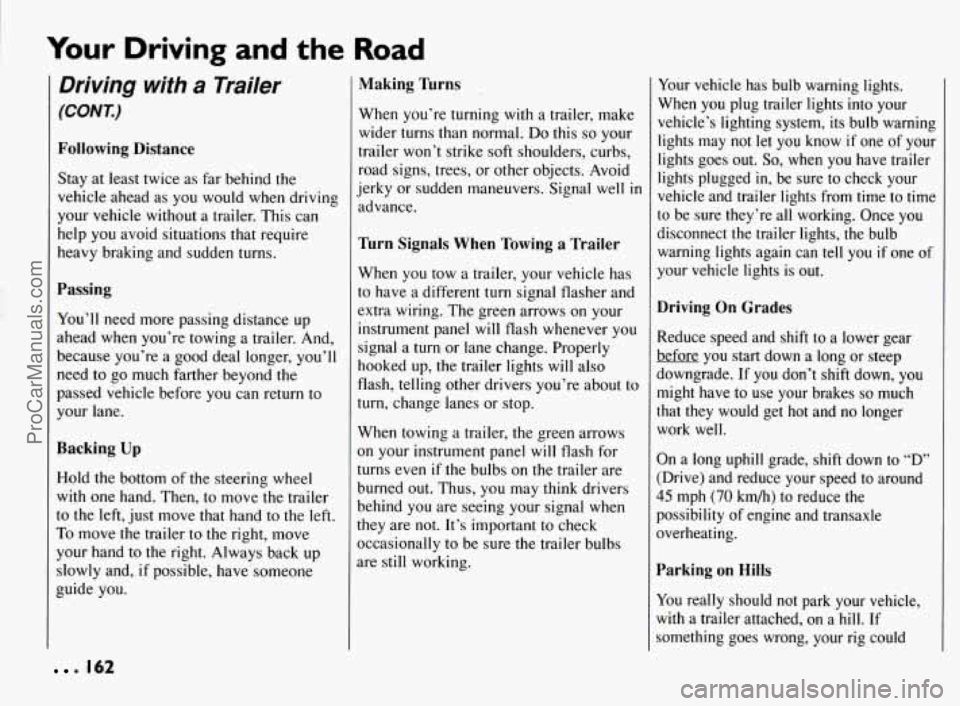
Your Driving and the Road
Driving with a Trailer
(CONT.)
Following Distance
Stay at least twice as far behind the
vehicle ahead as you would when driving
your vehicle without a trailer. This can
help you avoid situations that require
heavy braking and sudden turns.
Passing
You’ll need more passing distance up
ahead when you’re towing a trailer. And,
because you’re a good deal longer, you’ll
need to
go much farther beyond the
passed vehicle before you can return to
your lane.
Backing Up
Hold the bottom of the steering wheel
with one hand. Then, to move the trailer
to the left, just move that hand to the left.
To move the trailer to the right, move
your hand to the right. Always back up
slowly and,
if possible, have someone
guide you.
Making Turns
When you’re turning with a trailer, make
wider turns than normal. Do this
so your
trailer won’t strike soft shoulders, curbs,
road signs, trees, or other objects. Avoid
jerky or sudden maneuvers. Signal well
in
advance.
Turn Signals When Towing a Trailer
When you tow a trailer, your vehicle has
to have a different turn signal flasher and
extra wiring. The green arrows on your
instrument panel will flash whenever you
signal a turn or lane change. Properly
hooked up, the trailer lights will also
flash, telling other drivers you’re about to
turn, change lanes or stop.
When towing a trailer, the green arrows
on your instrument panel will flash for
turns even if the bulbs on the trailer are
burned out. Thus, you may think drivers
behind you are seeing your signal when
they are not. It’s important to check
occasionally to be sure the trailer bulbs
are still working. Your
vehicle has bulb warning lights.
When you plug trailer lights into your
vehicle’s lighting system, its bulb warning
lights may not let
you know if one of your
lights goes out.
So, when you have trailer
lights plugged
in, be sure to check your
vehicle and trailer lights from time
to time
to be sure they’re all working. Once you
disconnect the trailer lights, the bulb
warning lights again can tell you if one
of
your vehicle lights is out.
Driving On Grades
Reduce speed and shift to a lower gear
before you start down a long or steep
downgrade. If you don’t shift down, you
might have to use your brakes
so much
that they would get hot and no longer
work well.
On a long uphill grade, shift down to “D”
(Drive) and reduce your speed to around
45 mph (70 km/h) to reduce the
possibility
of engine and transaxle
overheating.
Parking on Hills
You really should not park your vehicle,
with a trailer attached, on a hill. If
something goes wrong, your rig could
. 162
ProCarManuals.com
Page 164 of 290

Parking on Hills
You really should not park your vehicle,
with a trailer attached, on a hill.
If
something goes wrong, your rig could
start to move. People can be injured, and
both your vehicle and the trailer can be
damaged.
But if you ever have to park your rig on a
hill, here’s how to do it:
1.
2.
3.
4.
5.
Apply your regular brakes, but don’t
shift into
“P” (Park) yet.
Have someone place chocks under the
trailer wheels.
When the wheel chocks are in place,
release the regular brakes until the chocks absorb the load.
Reapply the regular brakes. Then
apply your parking brake, and then shift to
“F”’ (Park).
Release the regular brakes.
When You Are Ready to Leave After
Parking
on a Hill
1.
2.
3.
4.
Apply your regular brakes and hold
the pedal down while you:
0 Start your engine;
Shift into a gear; and
0 Release the parking brake.
Let up on the brake pedal.
Drive slowly until the trailer is clear
of the chocks.
Stop and have someone pick up and
store the chocks.
Maintenance When Trailer Towing
Your vehicle will need service more often
when you’re pulling a trailer.
See the
Maintenance Schedule for more
on this.
Things that are especially important in
trailer operation are automatic transaxle
fluid (don’t overfill), engine oil, belt(s),
cooling system, and brake adjustment,
Each
of these is covered in this manual,
and the Index will help you find them
quickly. If you’re trailering, it’s a good
idea to review these sections before. you
start your trip.
Check periodically to
see that all hitch
nuts and bolts are tight.
,j.;
i .a
1. i
,
.?.
163...
ProCarManuals.com
Page 169 of 290
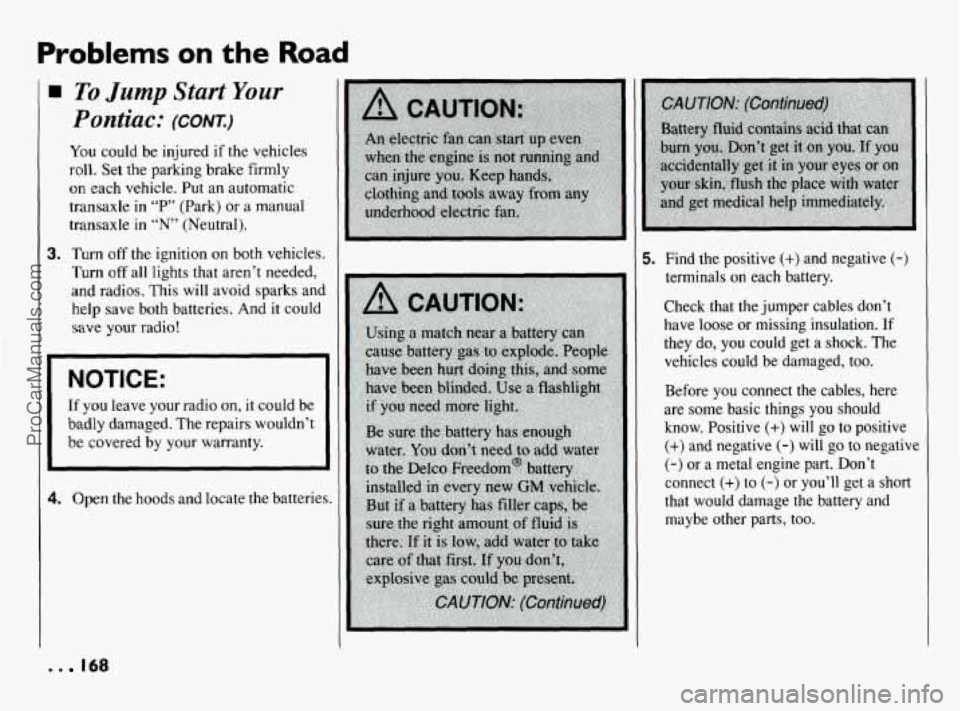
Problems on the Road
To Jump Start Your
Pontiac: (CONK)
You could be injured if the vehicles
roll. Set the parking brake firmly
on each vehicle. Put an automatic
transaxle
in “P” (Park) or a manual
transaxle
in “N” (Neutral).
3. Turn off the ignition on both vehicles.
Turn
off all lights that aren’t needed,
and radios. This will avoid sparks and
help save both batteries. And
it could
save your radio!
NOTICE:
~ ~~ ~~
If you leave your radio on, it could be
badly damaged. The repairs wouldn’t
be covered by your warranty.
4. Open the hoods and locate the batteries.
5. Find the positive (+) and negative (-)
terminals on each battery.
Check that
the jumper cables don’t
have loose or missing insulation. If
they do, you could get a shock. The
vehicles could be damaged, too.
Before you connect the cables, here
are some basic things you should
know. Positive
(+) will go to positive
(+) and negative (-) will go to negative
(-) or a metal engine part. Don’t
connect
(+) to (-) or you’ll get a short
that would damage the battery and maybe other parts, too.
. . 168
ProCarManuals.com
Page 172 of 290
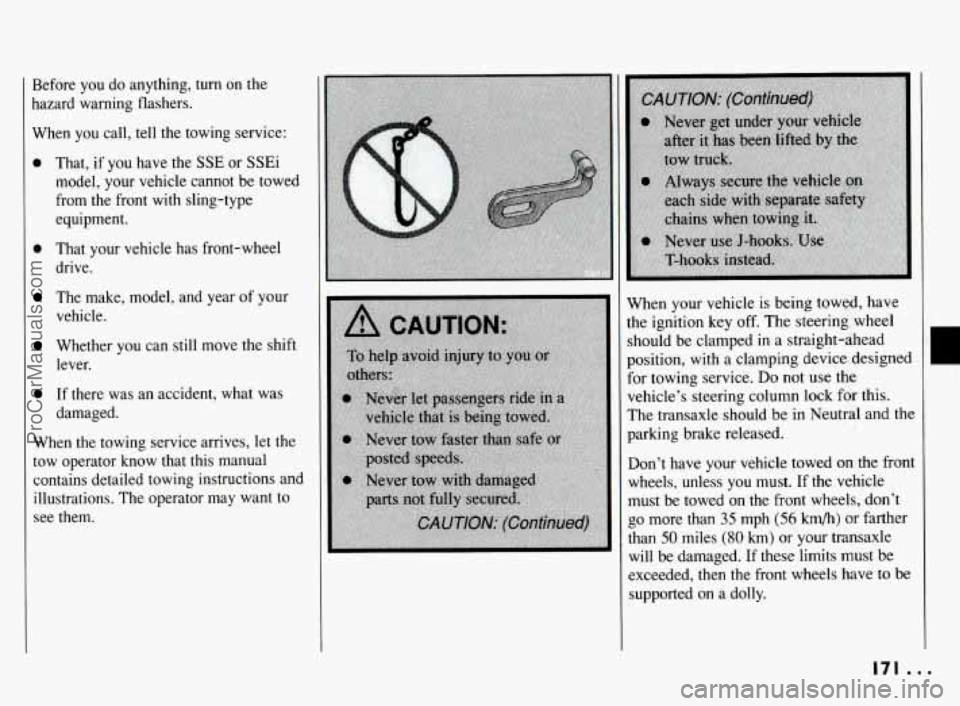
Before you do anything, turn on the
hazard warning flashers.
When you call, tell the towing service:
0 That, if you have the SSE or SSEi
model, your vehicle cannot be towed
from the front with sling-type
equipment.
0 That your vehicle has front-wheel
drive.
The make, model, and year of your
vehicle.
Whether you can still move the shift
lever.
0 If there was an accident, what was
damaged.
When the towing service arrives, let the
tow operator know that this manual
, contains detailed towing instructions and
illustrations. The operator may want to
see them. When
your vehicle is being towed, have
the ignition key
off. The steering wheel
should be clamped in a straight-ahead
position, with a clamping device designed
for towing service. Do not use the
vehicle’s steering column lock for this.
The transaxle should be in Neutral and the
parking brake released.
Don’t have your vehicle towed on the front
wheels, unless you must.
If the vehicle
must be towed on the front wheels, don’t
go more than 35 mph (56 km/h) or farther
than
50 miles (80 km) or your transaxle
will
be damaged. If these limits must be
exceeded, then the front wheels have
to be
supported on a dolly.
171 ...
c
ProCarManuals.com
Page 183 of 290
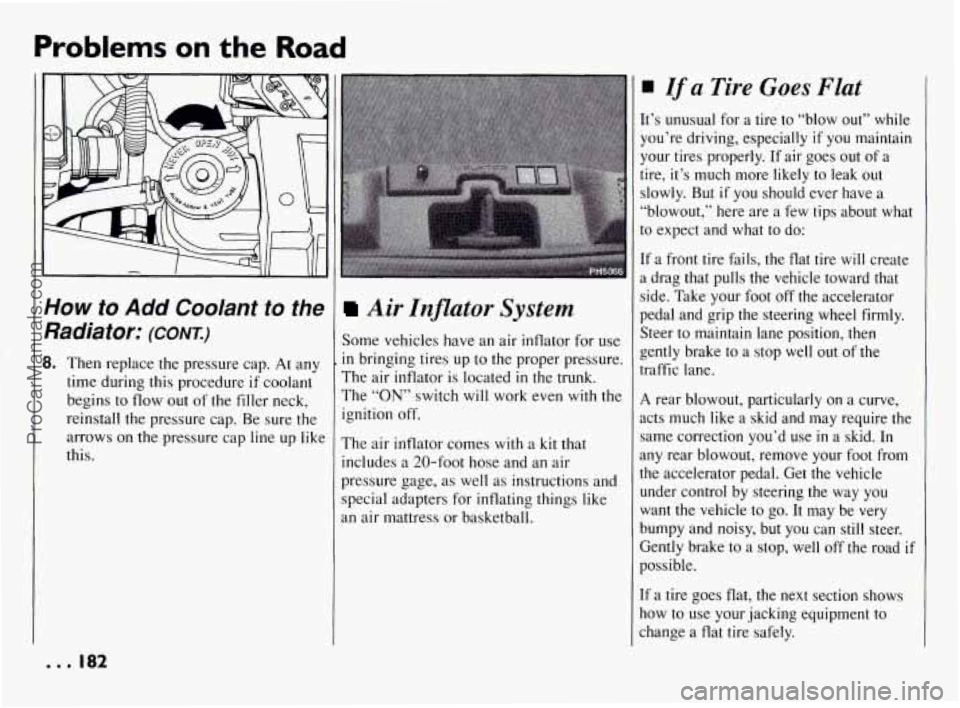
Problems on the Road
How to Add Coolant to the
Radiator:
(CONT.)
8. Then replace the pressure cap. At any
time during this procedure
if coolant
begins
to flow out of the filler neck,
reinstall the pressure cap. Be sure the
arrows
on the pressure cap line up like
this.
. . . 182
Air Inflator System
Some vehicles have an air inflator for use
in bringing tires up to the proper pressure.
The air inflator is located
in the trunk.
The “ON” switch will work even with the
ignition off.
The air inflator comes with a
kit that
includes a 20-foot hose and an air
pressure gage, as well as instructions and
special adapters for inflating things like
an air mattress or basketball.
If a Tire Goes FZat
It’s unusual for a tire to “blow out” while
you’re driving, especially
if you maintain
your tires properly. If air goes out of a
tire, it’s much more likely to leak out
slowly.
But if you should ever have a
“blowout,” here are a few tips about what
to expect and what to
do:
If a front tire fails, the flat tire will create
a drag that pulls the vehicle toward that
side. Take your foot
off the accelerator
pedal and grip
the steering wheel firmly.
Steer
to maintain lane position, then
gently brake
to a stop well out of the
traffic lane.
A rear blowout, particularly on a curve,
acts much like a skid and may require the
same correction you’d use
in a skid. In
my rear blowout, remove your foot from
the accelerator pedal. Get the vehicle
under control by steering the way you
want the vehicle
to go. It may be very
bumpy and noisy, but you can still steer.
Sently brake to a stop, well off the road
if
possible.
[fa tire goes flat, the next section shows
low
to use your jacking equipment to
:hange a flat tire safely.
ProCarManuals.com